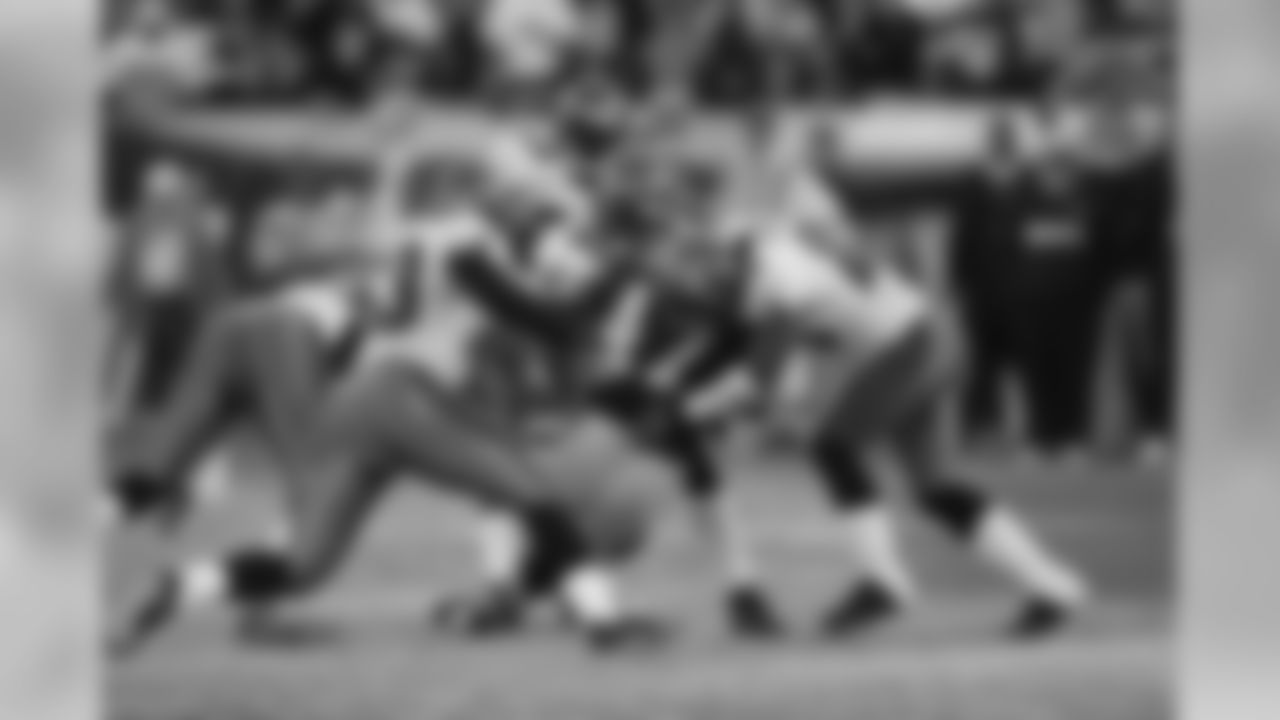Last November, thanks to a response regarding his approach to game-planning, Dirk Koetter was briefly labeled as an "anti-analytics" coach. When it comes to drawing up his play sheet for a specific opponent, Koetter values breaking down tape of that opponent over studying a page of team statistics.
In reality – and has gradually become clear over his two seasons with the Buccaneers, first as offensive coordinator and now as head coach – Koetter uses statistical analysis as much as any coach. Perhaps more than some. In particular, he has studied and distilled the factors that are most correlated with winning and regularly presents his team with a list of statistical goals before a game.
The distinction, as is always the case with statistics, is how they are wielded. Numbers can be illuminating, even predictive. For Koetter, they will never take the place of the scouting he can do with his own eyes, but they can assist in that process.
That's our goal with Football Geekery. Each week, we're going to give you a sampling of statistical and/or historical analysis, hopefully in a way that is relevant to the Buccaneers' current state of affairs. This week, noting the growing touchdown connection between Jameis Winston and Mike Evans, we search for the most prolific scoring combos ever for Tampa Bay and the league as a whole. We also compare continuity and performance of the Bucs' offensive lines through the past 40 years and note a sudden proliferation of 500-yard games under Koetter's direction.
**
1. Prolific Connections
Mike Evans has six touchdown receptions, the most any Buccaneer player has ever recorded through the first six games of a season. That total is already twice what he scored in 2015, his second NFL season, though it's only halfway to the team-record 12 he produced as a rookie.
With 21 touchdown catches through his first 36 professional games, Evans is rapidly climbing towards the top of the Buccaneers' all-time chart in that category. He ranks eighth already and could climb as high as third if he gets seven more in 2016. That would be an aggressive prediction, even at his current pace, but it seems possible given the obvious connection he has forged with young quarterback Jameis Winston. That connection was most plainly displayed last Sunday in San Francisco, when Evans signaled for Winston to throw him a jump ball in the end zone, leading to a bit of six-point improvisation between the two.
Assuming that Evans and Winston remain core players for the Buccaneers for years to come, it seems quite likely that they will eventually be the most prolific QB-WR touchdown combination in team annals. Thanks to long stretches of quarterback instability during the franchise's 41 years, the top spot is definitely not out of reach. (Tight ends are included in this analysis.)
Top 10 QB/Pass-Catcher Touchdown Combinations, Buccaneers History
|
Quarterback |
Pass-Catcher |
Seasons |
TDs |
|
Josh Freeman |
Mike Williams |
2010-13 |
24 |
|
Vinny Testaverde |
Mark Carrier |
1987-92 |
21 |
|
Vinny Testaverde |
Bruce Hill |
1987-90 |
20 |
|
Doug Williams |
Jimmie Giles |
1978-82 |
19 |
|
Doug Williams |
Kevin House |
1980-82 |
16 |
|
Brad Johnson |
Keenan McCardell |
2002-03 |
14 |
|
Trent Dilfer |
Dave Moore |
1996-99 |
14 |
|
Trent Dilfer |
Reidel Anthony |
1997-99 |
12 |
|
Steve DeBerg |
Gerald Carter |
1984-87 |
12 |
|
Steve DeBerg |
Jimmie Giles |
1984-86 |
10 |
One more and the Winston-Evans combo will already be in the top 10, and the #1 spot will conceivably be in reach in 2017. Hopefully, Winston and Evans blow well past that top mark in the seasons to come, setting the bar much higher for future combinations of Buc teammates. At the moment, Tampa Bay has the lowest top mark in this category of the 32 teams currently in the league.
Top QB/Pass-Catcher Touchdown Combinations, Each NFL Team
|
Passer |
Pass-Catcher |
Seasons |
Team |
TDs |
|
Peyton Manning |
Marvin Harrison |
1998-2008 |
IND |
112 |
|
Steve Young |
Jerry Rice |
1987-99 |
SF |
85 |
|
Dan Marino |
Mark Clayton |
1983-92 |
MIA |
79 |
|
Philip Rivers |
Antonio Gates |
2006-16 |
SD |
79 |
|
Drew Brees |
Marques Colston |
2006-15 |
NO |
72 |
|
Tom Brady |
Rob Gronkowski |
2010-16 |
NE |
66 |
|
Jim Kelly |
Andre Reed |
1986-96 |
BUF |
65 |
|
Otto Graham |
Dante Lavelli |
1946-55 |
CLE |
57 |
|
Brett Favre |
Antonio Freeman |
1995-2001 |
GB |
57 |
|
Matthew Stafford |
Calvin Johnson |
2009-15 |
DET |
56 |
|
Daunte Culpepper |
Randy Moss |
2000-04 |
MIN |
53 |
|
Sonny Jurgensen |
Charley Taylor |
1964-74 |
WAS |
53 |
|
Matt Ryan |
Roddy White |
2008-15 |
ATL |
52 |
|
Ken Anderson |
Isaac Curtis |
1973-83 |
CIN |
51 |
|
Tony Romo |
Dez Bryant |
2010-15 |
DAL |
50 |
|
Terry Bradshaw |
Lynn Swann |
1974-81 |
PIT |
49 |
|
Neil Lomax |
Roy Green |
1981-88 |
AZ |
48 |
|
Ron Jaworski |
Harold Carmichael |
1977-83 |
PHI |
47 |
|
Len Dawson |
Otis Taylor |
1965-74 |
KC |
46 |
|
Marc Bulger |
Torry Holt |
2002-08 |
RAM |
46 |
|
Dave Krieg |
Steve Largent |
1981-89 |
SEA |
46 |
|
Mark Brunell |
Jimmy Smith |
1995-2002 |
JAX |
44 |
|
Ken Stabler |
Cliff Branch |
1973-79 |
OAK |
44 |
|
Warren Moon |
Drew Hill |
1985-91 |
TEN |
43 |
|
Joe Namath |
Don Maynard |
1965-72 |
NYJ |
42 |
|
Jake Delhomme |
Steve Smith |
2003-09 |
CAR |
41 |
|
John Elway |
Shannon Sharpe |
1990-98 |
DEN |
41 |
|
Eli Manning |
Plaxico Burress |
2005-08 |
NYG |
33 |
|
Matt Schaub |
Andre Johnson |
2007-12 |
HOU |
32 |
|
Joe Flacco |
Torrey Smith |
2011-14 |
BAL |
30 |
|
Sid Luckman |
Ken Kavanaugh |
1940-48 |
CHI |
29 |
|
Josh Freeman |
Mike Williams |
2010-13 |
TB |
24 |
2. Continuity Up Front
The Buccaneers did not get good offensive line play in 2014, which prompted the drafting of tackle Donovan Smith and guard Ali Marpet in the second round of the 2015 draft. Despite a preseason injury to incumbent right tackle Demar Dotson and the late additions of Gosder Cherilus and Joe Hawley, the Buccaneers did enjoy a fine season from the offensive line last year. By some measures, it was as good as a Tampa Bay offensive line has ever played.
Earlier this week, Koetter noted that there are often disagreements between evaluations of the performances of an offensive line by outside sources and how that unit's play is viewed inside team headquarters.
WATCH: PEWTER PANEL, WEEK 8
"Since I came here over a year ago, I've always said, 'Our O-line gets beat up way more than they deserve,'" said Koetter. "There are plenty of teams that have O-line issues and we feel like we have pretty decent depth on our O-line all the way down into our practice squad. We feel good about the guys we've got and they're playing well together. I know there are the critics out there that have their own grading scale, the mysterious grading scale. We look at our own grading scale. We're going to grade them how - because we know what they are supposed to be doing every play. Other people that grade them, how do you grade someone when you don't know what they are supposed to do? But, I think –I've always thought – our O-line, they play hard, they play together. They're not perfect, but I'll take them on my team any day."
In statistical terms, it has always been difficult to get a quick assessment of the play of an offensive line, or in particular, individual linemen. Still, there are some team stats that certainly seem to reflect on the O-Line's performance, such as sacks allowed per pass play, rushing yards per game and yards per carry. In 2015, the Buccaneers ran for 4.75 yards per attempt, which was the best single-season mark in team history. The Bucs also gained 135.1 yards on the ground per contest, the second-best mark in Buc annals. Quarterback Jameis Winston was sacked on 4.8% of his dropbacks, which ranked seventh among the Bucs' first 40 seasons. If one ranked all 40 Buccaneer seasons in each of those three categories, then averaged those rankings for each campaign, the 2015 season is at the top, with an average ranking of 3.33.
VIEW: WEEK 8 EXPERT PICKS
One thing that benefited last year's line was a great deal of continuity. Even with Dotson's preseason mishap and an early-season injury to center Evan Smith, the Bucs fielded the same five-man line most games. That's been the case so far this season for the Buccaneers, who have not only started the same five offensive linemen in all five games but have rarely seen any of those five miss a snap. Smith and Marpet have each played 100% of the team's offensive snaps, while Dotson is at 99%, left guard Kevin Pamphile is at 97% and Hawley is at 94%.
Is that sort of continuity common to the better offensive lines in Buccaneer history? For the most part, yes. If we rank all 40 Buc teams from 1976-2015 in terms of their combined performance in rushing yards per game, yards per carry and sacks allowed per pass play, we do find the teams at the top enduring less in-season turnover.
In the two charts below, you'll see the top five seasons and the bottom five seasons in Buc history based on average ranking in those three categories. Again, by ranking we mean ordering the 40 Tampa Bay seasons from 1-40, not each team's rankings within the NFL. By each season we've listed the five O-Line positions and the number of starts made at each position in each season by the player who opened the most games. The final two columns list the totals of those five numbers combined and the percentage that is of the total number of possible O-Line starts. The 1977 season was 14 games long, not 16, so we've adjusted the percentage to account for that. The 1987 season included a players' strike and three games played by replacement players. We're counting only the 12 non-strike games that year.
Top Five
|
Season |
Avg. Rank |
LT |
LG |
C |
RG |
RT |
Total |
Pct. |
|
2015 |
3.33 |
16 |
15 |
14 |
13 |
14 |
72 |
90.0% |
|
1979 |
4.67 |
16 |
16 |
16 |
16 |
14 |
78 |
97.5% |
|
2010 |
6.33 |
16 |
11 |
8 |
11 |
9 |
55 |
68.8% |
|
2012 |
7.00 |
16 |
9 |
9 |
12 |
15 |
61 |
76.3% |
|
1998 |
8.33 |
16 |
12 |
16 |
16 |
15 |
75 |
93.8% |
Bottom Five
|
Season |
Avg. Rank |
LT |
LG |
C |
RG |
RT |
Total |
Pct. |
|
1987 |
32.33 |
5 |
8 |
12 |
12 |
6 |
43 |
71.7% |
|
2001 |
33.33 |
16 |
16 |
15 |
16 |
16 |
79 |
98.8% |
|
1993 |
33.67 |
10 |
10 |
16 |
14 |
8 |
58 |
72.5% |
|
1977 |
35.33 |
14 |
8 |
10 |
14 |
13 |
59 |
84.3% |
|
1983 |
37.33 |
11 |
6 |
10 |
9 |
13 |
49 |
61.3% |
There is a glaring exception in each group. The Buccaneers performed well in those three key categories in 2010 despite quite a bit of O-Line turnover caused by injuries to Jeff Faine, Davin Joseph and Jeremy Trueblood, as well as the ill-fated decision to start Keydrick Vincent at left guard. On the other hand, a great deal of continuity didn't lend much help to the 2001 line, which was anchored by Kenyatta Walker at left tackle and had free agent acquisitions and former Minnesota Vikings Randall McDaniel and Jeff Christy at left guard and center, respectively.
Still, as you can see in the final column of each chart, three of the top five teams had their main five make 90% or better of the possible starts. Three of the bottom five were at 72.5% or worse. The Buccaneers believe they're getting very good play from their O-Line in 2016, and believe that group is steadily getting better. If the same starting lineup can remain intact for most of the season, the results likely will continue to improve.
3. Cracking 500
The Buccaneers gained 513 net yards of offense in their win over San Francisco last Sunday, their high-water mark for the season. That marks the third time since Koetter took over Tampa Bay's play-calling duties in 2015 that the team has surpassed 500 yards in a game. That's three times in 22 games. Remarkably, the Buccaneers had only had three 500-yard games in their first 39 seasons and 61 regular-season games.
A look back at all of the match-ups between the Buccaneers and the Raiders.

Nov. 4 2012, W 42-32

Nov. 4 2012, W 42-32

Dec. 28 2008, L 24-31

Dec. 28 2008, L 24-31

Sep. 26 2004, L 20-30

Sep. 26 2004, L 20-30

Jan. 26 2003, W 48-21

Jan. 26 2003, W 48-21

Dec. 19 1999, L 0-45

Dec. 19 1999, L 0-45

Nov. 10 1996, W 20-17

Nov. 10 1996, W 20-17

Dec. 19 1993, L 20-27

Dec. 19 1993, L 20-27

Oct. 18 1981, L 16-18

Oct. 18 1981, L 16-18Not Pictured:Nov. 28 1976, L 16-49
Obviously, the NFL has gradually become a more offensive game. Through the first seven weeks of the 2016 season, teams are averaging 355.5 yards per game, which would set a new single-season record for the NFL if it is maintained. If the NFL does set a new record for yards in 2016, it will be the seventh time it has done so in the last eight years. (The last eight seasons rank 1-8 in that category, but the 2014 season actually was a slight decline from 2013 before another new record was set in 2015).
Thus, it's not surprising that if the Bucs were to have a run of 500-yard games over a two-year period it would happen in 2015-16 and not, say, 1985-86. Even so, it has been an impressive showing for Koetter's offense. The only team with more 500-yard games than Tampa Bay over the past season-and-a-half is New Orleans, with four. Pittsburgh also has three and four other teams have two, but 13 of the league's 32 teams have not had a single 500-yard outing in the past two years.
Each of the current 32 NFL teams is listed below, along with the number of 500-yard games they've had all-time and the number they've had in the last two years. It's not fair to compare the Bucs' percentage of overall 500-yard games that have come in 2015-16 to other teams because that would penalize them for having more such outings overall. However, the chart does make it clear that, in terms of yards, no other team in the league has improved as much as Tampa Bay has since Koetter's arrival.
500-Yard Offensive Games for Each NFL Franchise
|
Team |
All-Time |
2015-16 |
Team |
All-Time |
2015-16 |
|
|
AZ |
18 |
1 |
LA |
35 |
0 |
|
|
ATL |
9 |
2 |
MIA |
14 |
1 |
|
|
BAL |
5 |
0 |
MIN |
18 |
0 |
|
|
BUF |
8 |
0 |
NE |
20 |
2 |
|
|
CAR |
3 |
1 |
NO |
28 |
4 |
|
|
CHI |
20 |
1 |
NYG |
19 |
2 |
|
|
CIN |
23 |
1 |
NYJ |
14 |
0 |
|
|
CLE |
23 |
1 |
OAK |
25 |
0 |
|
|
DAL |
21 |
1 |
PHI |
27 |
1 |
|
|
DEN |
32 |
2 |
PIT |
23 |
3 |
|
|
DET |
16 |
1 |
SD |
26 |
1 |
|
|
GB |
22 |
0 |
SF |
25 |
0 |
|
|
HOU |
5 |
0 |
SEA |
14 |
1 |
|
|
IND |
23 |
0 |
TB |
6 |
3 |
|
|
JAX |
2 |
0 |
TEN |
14 |
0 |
|
|
KC |
26 |
0 |
WAS |
19 |
1 |






















